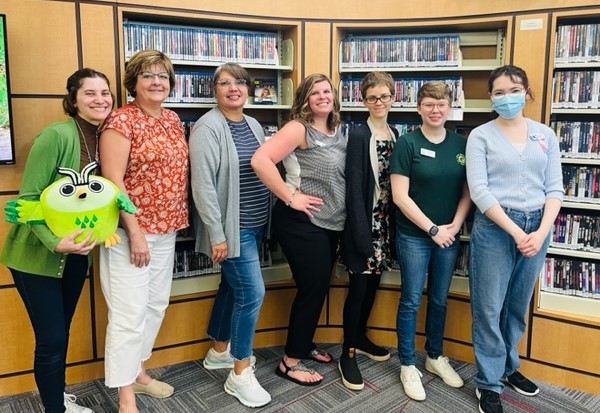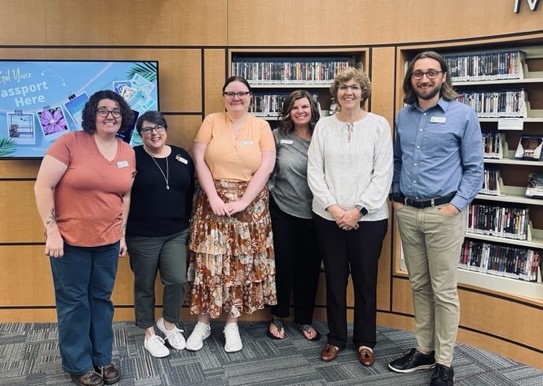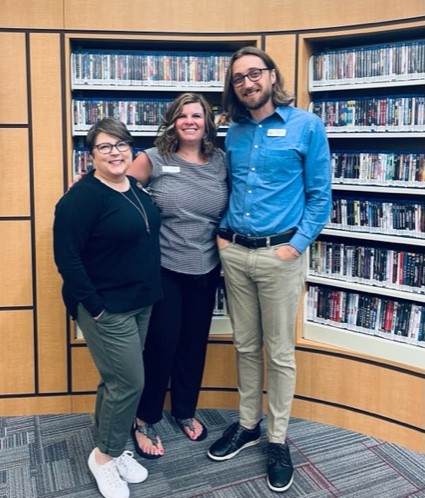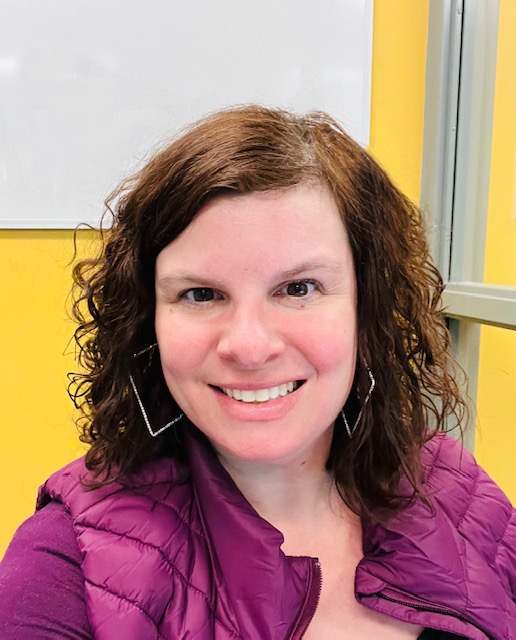By: Kelli Merriman
Kelli was the Social Work intern for the O’Fallon Public Library during the spring and summer, and did a wonderful job connecting with the community and providing patrons with resources. In her final blog for us, she shares some of her personal story and experiences with disability.

Since childhood, I have had to defy stereotypes related to my disability. I am diagnosed with a neurological disability called Cerebral Palsy, (CP) which impacts me physically. I was held back a grade after kindergarten, because school officials assumed that because of my physical disability I was also intellectually impaired. Once it was discovered that I was not cognitively impaired, I participated in all general education classes in grade school and high school. In fact, I made honor roll during junior high and high school and was consistently on the Dean’s list in college.
As the only physically disabled student in class, there were times when my peers or my teachers insisted on doing things for me, like carrying my lunch tray for me (assuming that I would drop it). Sometimes I was left out of games, such as “Red Rover”, and I often sat on the sidelines watching my peers during PE because they assumed I couldn’t participate because of my disability. These experiences left me feeling discouraged and excluded.
Statistics
According to the World Health Organization (2023), over a billion individuals worldwide are disabled. Disabled individuals make up the largest minority group in the United States (A Quick History of Disability Rights, 2020). In America, over twenty-five percent of adults are diagnosed with a disability (Centers for Disease Control and Prevention, 2023). Babik and Gardener (2021) define a disability as a physical or mental impairment that hinders one’s ability to participate fully in social or work activities in society. Adults diagnosed with disabilities are more likely to be diagnosed with diabetes, heart disease, or cancer than non-disabled adults (Centers for Disease Control and Prevention, 2023).
People experiencing disabilities deserve to be included. Though their participation may depend on the specifics of their abilities, adults with disabilities should be encouraged to participate in activities in society regardless. Disability inclusion is important because it allows opportunities to participate in social or meaningful work or leisure activities to the best of one’s ability. While some with disabilities are able to volunteer or work in the community, others may struggle to be gainfully employed. Nonetheless, communities should hold positive attitudes towards those with disabilities, and encourage inclusion to the fullest extent, recognizing the strengths and abilities of each disabled person (Babik and Gardener, 2021).
Rising Above
During middle school, things took a turn for the better. I started to seek out opportunities to be included. I wanted to play in band and participate in sports, just like my peers. My school’s band teacher helped me excel at playing an instrument, the trumpet, with one hand. I tried out for basketball, despite the coach’s doubt of my capability. And even though I didn’t make that team, I still found a place in the athletics world on the track team. I ran 4×4 relays with my teammates. I was part of the team and felt included.

Not the Problem
During high school, I started to gain more confidence and remained proactive about being included in activities. I continued track by throwing the shot put and discus. I attended school dances, homecoming events, and even had the opportunity to participate in the Miss Teen of America pageant. I learned a ton about confidence and self-acceptance. Nonetheless, my disability still presented problems for me. I pretended to be sick every morning so I could skip PE when my class had to go to the community pool. I knew I could not swim like my able-bodied peers and felt so embarrassed when it was time for me to try to swim laps against an opponent.
When it came time for me to begin driver’s education, my mom was informed by my instructor that I would present a safety hazard because I could only operate a vehicle with one hand. After she advocated for me by speaking up about my abilities to school administration, I ended up taking the course and getting my driver’s license as anticipated on the day that I turned age 16. Driving felt normal to me and I did not experience any difficulty.
The Desire to Work
When I thought about college and a career as a young adult, I thought I wanted to study neuroscience so I could find a way to correct my disability. It wouldn’t be until years later that I realized that my disability was not the problem. Going into the workforce wasn’t easy, due to my inability to perform the physical tasks that were required in most jobs. I was approved for Supplemental Security Income (SSDI) at age 18. However, the income from this program was low. I not only felt ashamed to receive disability benefits, but I had a strong desire to find a job that I could physically do.
As a young adult, my goal was to be able to support myself without the help of my parents or government assistance. I began to babysit part-time for a family while I was in my late teens. I helped the children with homework, made them dinner, and ensured that they were safe. These were all tasks I excelled at. I felt supported by the parents and I adored the children too. This was my first job, which I was able to keep until the kids were old enough to care for themselves.
My next adventure was working part-time at a group home to support adults that experienced cognitive disabilities. In my role as direct support worker, I helped these individuals with activities of daily living, and provided them with support and encouragement. It was a job I had the stamina and physical capacity to do part-time, which made me feel proud.
My first two jobs led me to the field of psychology because I realized that I wanted to make a difference in the lives of others. After graduation, I was able to continue my role in helping others after being offered a position as a case manager with a mental health agency. I took clients to their appointments, facilitated social groups, taught them about their medications, and provided mental health support. I felt supported by my supervisor and fellow colleagues. It was at this job that I finally taught myself how to type quickly with one hand. I felt happy and accomplished.
Eventually, the time came when I decided to go back to school, this time to pursue a master’s degree in Special Education. In graduate school, I met the man of my dreams and got married. Right after graduation, I had to move away because my husband had orders to be stationed in Tampa, Florida. In addition to becoming a new mom, I found gainful employment as an Extended Transition teacher in St. Petersburg. I taught adult students life skills and vocational skills. Being a teacher and helping those with special needs was rewarding and made me so happy! I felt supported by my colleagues and administrators.
Unfortunately, I missed my family back in Illinois. When my husband’s orders were up, we moved back to Illinois. I was unable to find a teaching job quickly upon my return to Illinois, but I was offered a job at the same mental health agency I worked for, this time as a mental health coordinator. After a year and a half of being a supervisor, I realized that I still really wanted to use my teaching degree even though I loved supporting both staff and students in my role as a supervisor.
A Major Setback
Unfortunately, my re-entry to work in Illinois was not without challenges. I accepted the first position I was offered, at a company that served students diagnosed with severe disabilities. I did not disclose my disability during the interview. Doing so can unfortunately open people up to discrimination, and I felt confident in my ability to work for this company too.
Unfortunately, despite the occasional assistance from paraprofessionals to help with my classroom of 3rd and 4th graders who were diagnosed with severe Autism, I quickly realized that I could not keep up with the physical demands of my students. I could not chase after them when they decided to elope. I could not block punches with both of my hands. I could not physically escort a student back into the classroom when they decided they did not want to leave the playground after recess was over. I could not use CPI (crisis prevention institute) restraints independently when they were required as a last resort. This made me feel scared and discouraged, especially when the paraprofessionals that were usually assigned to my room were absent or away for their lunch breaks. I was failing at keeping my classroom safe and I knew it.
Just as I was getting ready to resign and return full-time to the mental health agency I previously worked for, I discovered that the company had a teaching opening available with their transition students. Though these transition students were also diagnosed with severe Autism, all I could focus on was the success I achieved in Florida working as a transition teacher. I became hopeful that I could do well in this new position, based on my previous transition teaching experience and my experience working in mental health with adults.
I did have one incident, on my first day, where I got a little too close to a student and was struck in the face. After that day, I was mindful to give my students additional space. I took time to get to know each of their strengths, their needs, and their triggers. I immediately recognized that the transition students were more mature than the 3rd and 4th graders I previously served. They were also more responsive to redirection and required less physical intervention.
I made it successfully through my first year with the transition students. During my second year of teaching, I found out that I was pregnant with my second child. Though my husband and other family members worried that I would get injured at work, I felt confident in my role as a Special Educator, so I stayed employed throughout my pregnancy. I ended up working one-on-one with the most challenging students while pregnant. To the surprise of many, I did not sustain a single injuries. I attribute this success to my experience in working with a population that can struggle behaviorally.
Unfortunately, after coming back from maternity leave, I was told that I would be assigned to teach 5th grade students. Knowing that I was previously unsuccessful working with 4th graders, I felt there was a strong possibility that I would not physically be able to keep up with the 5th grade students. I took a leave of absence, hoping that I would be able to work through the accommodation process.
Despite working with my union and presenting a doctor’s note that I was not able to physically respond to frequent behaviors of students due to my disability, I was denied the chance to return to my previously successful position as a transition teacher. I was terminated from my employer. I felt defeated, discouraged, and silenced.
Gaining Strength
After a year of battling sadness and anxiety, I finally gained the strength to apply for a new teaching position in a school district that had excellent reviews. I wasn’t hired after my first interview, but I didn’t give up. I applied again. I was offered a position as a part-time Special Education teacher. I accepted the position with confidence and a smile.
Four years later, here I am, still employed in this district as a Special Education teacher, now as a full-time employee. I am able to perform all job tasks without accommodation, but upon hire the principal was kind enough to ask me if I needed one based on my request for one at my last job. I feel valued, respected, and included by administrators and all other staff at this school.

I have come to realize that there are employers that value diversity, fully support their employers, and want to ensure the success of students and staff. I am grateful to have an exceptional employer like this. Today, as a Special Educator and Social Worker, I aim to support and empower disabled individuals and other marginalized groups. I have learned to embrace my disability, but refuse to let it define me. I am a woman who no longer wants to change herself physically, but society’s view of her instead.
Disability Resources
Social Security Administration: (800) 772-1213
The United States Social Security Administration | SSA
Illinois Department of Human Services Division of Rehabilitation Services: (618) 235-5300
IDHS: Rehabilitation Services (state.il.us)
Illinois Department on Aging: 1-800-252-8966
Linc Inc.: (618) 235-9988
Chestnut Health Systems (Belleville): (618) 877-4420
References
Babik, I. & Gardner, E. (2021). Factors Affecting the perception of disability: a developmental
perspective. Frontiers in Psychology, 12 (1), 1-26.
CDC (2023). Disability impacts all of us. Retrieved from
https://www.cdc.gov/ncbddd/disabilityandhealth/infographic-disability-impacts-all.html
A Quick History of Disability Rights (2020). GT Independence. Retrieved from
World Health Organization (2023). Retrieved from
https://www.who.int/news-room/fact-sheets/detail/disability-and-health
World Health Organization (2023). Retrieved from
https://www.who.int/news-room/fact-sheets/detail/disability-and-health
